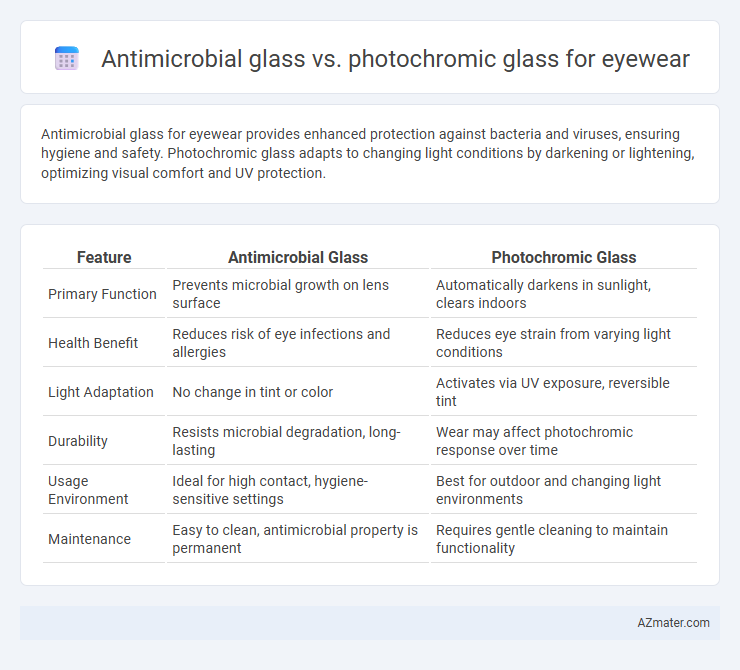Antimicrobial glass for eyewear provides enhanced protection against bacteria and viruses, ensuring hygiene and safety. Photochromic glass adapts to changing light conditions by darkening or lightening, optimizing visual comfort and UV protection.
Table of Comparison
| Feature | Antimicrobial Glass | Photochromic Glass |
|---|---|---|
| Primary Function | Prevents microbial growth on lens surface | Automatically darkens in sunlight, clears indoors |
| Health Benefit | Reduces risk of eye infections and allergies | Reduces eye strain from varying light conditions |
| Light Adaptation | No change in tint or color | Activates via UV exposure, reversible tint |
| Durability | Resists microbial degradation, long-lasting | Wear may affect photochromic response over time |
| Usage Environment | Ideal for high contact, hygiene-sensitive settings | Best for outdoor and changing light environments |
| Maintenance | Easy to clean, antimicrobial property is permanent | Requires gentle cleaning to maintain functionality |
Introduction to Modern Eyewear Technologies
Antimicrobial glass in eyewear incorporates additives like silver ions to inhibit bacterial growth, enhancing hygiene and reducing lens smudging. Photochromic glass features light-sensitive molecules that darken upon UV exposure, providing dynamic tint adjustment for outdoor and indoor use. Both technologies offer advanced functionality, with antimicrobial glass focusing on cleanliness and photochromic glass optimizing visual comfort and protection.
What is Antimicrobial Glass?
Antimicrobial glass for eyewear is specially treated with coatings that inhibit the growth of bacteria, fungi, and other microbes on the lens surface, ensuring enhanced hygiene and durability. This technology reduces the risk of eye infections and maintains clearer vision by preventing smudges caused by microbial buildup. Compared to photochromic glass, which primarily adapts to light conditions, antimicrobial glass focuses on health benefits and cleanliness without altering lens tint.
Key Features of Photochromic Glass
Photochromic glass for eyewear features lenses that automatically darken in response to ultraviolet (UV) light, providing adaptive protection against sun glare while maintaining clear vision indoors. These lenses contain light-sensitive molecules, such as silver halide or organic photochromic compounds, which undergo a reversible chemical transformation to adjust tint intensity. Photochromic glass enhances visual comfort and convenience by eliminating the need to switch between different pairs of glasses, contrasting with antimicrobial glass that primarily focuses on reducing microbial growth on lens surfaces.
Benefits of Antimicrobial Glass Lenses
Antimicrobial glass lenses offer continuous protection against harmful bacteria and fungi, reducing the risk of eye infections and promoting better hygiene for eyewear users. These lenses maintain clarity and durability while preventing microbial buildup, which enhances overall lens longevity and user comfort. Compared to photochromic glass, antimicrobial lenses provide a specialized health benefit without relying on light-activated tint changes.
Advantages of Photochromic Eyewear
Photochromic eyewear automatically adjusts lens tint based on ambient light, providing seamless protection from UV rays and reducing glare in bright environments. This adaptive feature enhances visual comfort and eye health by minimizing strain during transitions between different lighting conditions. Unlike antimicrobial glass, which primarily inhibits microbial growth, photochromic lenses offer dynamic light modulation, making them ideal for users seeking versatile and functional eyewear.
Antimicrobial vs Photochromic: Performance Comparison
Antimicrobial glass for eyewear offers superior hygiene by actively inhibiting bacterial growth and reducing the risk of infection, making it ideal for medical or high-contact environments. Photochromic glass excels in adaptive light management by darkening in sunlight and clearing indoors, enhancing visual comfort and eye protection from UV rays. While antimicrobial glass prioritizes sanitation and surface cleanliness, photochromic glass focuses on dynamic vision enhancement and UV protection, defining their distinct performance benefits.
Durability and Maintenance: Which Glass Lasts Longer?
Antimicrobial glass for eyewear offers enhanced resistance to bacteria and smudges, reducing the need for frequent cleaning and contributing to longer-lasting clarity. Photochromic glass, while providing adaptive tinting based on light exposure, may face durability challenges due to repeated chemical changes that can degrade its responsiveness over time. Overall, antimicrobial glass tends to require less maintenance and retains its properties longer, whereas photochromic glass demands careful handling to preserve its photo-reactive function.
Health and Safety Implications
Antimicrobial glass for eyewear incorporates coatings that inhibit bacterial and viral growth, significantly reducing the risk of infection transmission, making it ideal for healthcare and high-contact environments. Photochromic glass enhances eye protection by automatically adjusting tint according to UV exposure, reducing glare and minimizing eye strain, which supports long-term ocular health. Combining antimicrobial properties with photochromic technology offers advanced health and safety benefits by both limiting microbial contamination and providing dynamic visual comfort.
Cost Considerations and Affordability
Antimicrobial glass for eyewear typically incurs higher upfront costs due to specialized coatings that inhibit bacterial growth, making it a premium option for health-conscious consumers. Photochromic glass, which darkens in response to UV light, generally offers moderate pricing but may require replacement more frequently due to photo-reactive material degradation over time. Consumers seeking durable, cost-effective eyewear might favor photochromic lenses, while those prioritizing hygiene and long-term investment may find antimicrobial coatings justify the additional expense.
Choosing the Right Glass for Your Eyewear Needs
Antimicrobial glass offers enhanced hygiene by inhibiting the growth of bacteria and microbes on the lens surface, making it ideal for environments requiring frequent sanitation and reducing eye infections. Photochromic glass dynamically adjusts tint based on exposure to UV light, providing optimal vision clarity and comfort both indoors and outdoors by automatically darkening in bright sunlight. Choosing the right glass depends on whether your priority is hygienic safety or adaptive light sensitivity for varied lighting conditions.

Infographic: Antimicrobial glass vs Photochromic glass for Eyewear
 azmater.com
azmater.com